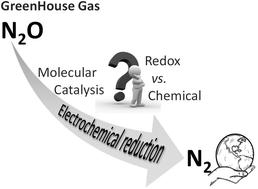当前位置:
X-MOL 学术
›
Chem. Sci.
›
论文详情
Our official English website, www.x-mol.net, welcomes your feedback! (Note: you will need to create a separate account there.)
Homogeneous molecular catalysis of the electrochemical reduction of N2O to N2: redox vs. chemical catalysis
Chemical Science ( IF 8.4 ) Pub Date : 2021-08-24 , DOI: 10.1039/d1sc03044b Rana Deeba 1 , Sylvie Chardon-Noblat 1 , Cyrille Costentin 1, 2
Chemical Science ( IF 8.4 ) Pub Date : 2021-08-24 , DOI: 10.1039/d1sc03044b Rana Deeba 1 , Sylvie Chardon-Noblat 1 , Cyrille Costentin 1, 2
Affiliation

|
Homogeneous electrochemical catalysis of N2O reduction to N2 is investigated with a series of organic catalysts and rhenium and manganese bipyridyl carbonyl complexes. An activation-driving force correlation is revealed with the organic species characteristic of a redox catalysis involving an outer-sphere electron transfer from the radical anions or dianions of the reduced catalyst to N2O. Taking into account the previously estimated reorganization energy required to form the N2O radical anions leads to an estimation of the N2O/N2O˙− standard potential in acetonitrile electrolyte. The direct reduction of N2O at a glassy carbon electrode follows the same quadratic activation driving force relationship. Our analysis reveals that the catalytic effect of the mediators is due to a smaller reorganization energy of the homogeneous electron transfer than that of the heterogeneous one. The physical effect of “spreading” electrons in the electrolyte is shown to be unfavorable for the homogeneous reduction. Importantly, we show that the reduction of N2O by low valent rhenium and manganese bipyridyl carbonyl complexes is of a chemical nature, with an initial one-electron reduction process associated with a chemical reaction more efficient than the simple outer-sphere electron transfer process. This points to an inner-sphere mechanism possibly involving partial charge transfer from the low valent metal to the binding N2O and emphasizes the differences between chemical and redox catalytic processes.
中文翻译:

N2O 电化学还原为 N2 的均相分子催化:氧化还原与化学催化
使用一系列有机催化剂和铼锰联吡啶羰基配合物研究了N 2 O 还原为 N 2 的均相电化学催化。通过氧化还原催化的有机物种特征揭示了活化驱动力相关性,涉及从还原催化剂的自由基阴离子或二价阴离子到 N 2 O的外球电子转移。考虑到先前估计的形成所需的重组能量N 2 O 自由基阴离子导致对乙腈电解质中N 2 O/N 2 O˙ -标准电位的估计。N 2的直接还原玻碳电极上的 O 遵循相同的二次激活驱动力关系。我们的分析表明,介体的催化作用是由于同质电子转移的重组能比异质电子转移的重组能小。电解质中“扩散”电子的物理效应不利于均匀还原。重要的是,我们表明低价铼和锰联吡啶羰基配合物对 N 2 O的还原具有化学性质,初始单电子还原过程与化学反应相关,比简单的外球电子转移过程更有效. 这表明内部球体机制可能涉及部分电荷从低价金属转移到结合的 N2 O 并强调化学和氧化还原催化过程之间的差异。
更新日期:2021-09-03
中文翻译:

N2O 电化学还原为 N2 的均相分子催化:氧化还原与化学催化
使用一系列有机催化剂和铼锰联吡啶羰基配合物研究了N 2 O 还原为 N 2 的均相电化学催化。通过氧化还原催化的有机物种特征揭示了活化驱动力相关性,涉及从还原催化剂的自由基阴离子或二价阴离子到 N 2 O的外球电子转移。考虑到先前估计的形成所需的重组能量N 2 O 自由基阴离子导致对乙腈电解质中N 2 O/N 2 O˙ -标准电位的估计。N 2的直接还原玻碳电极上的 O 遵循相同的二次激活驱动力关系。我们的分析表明,介体的催化作用是由于同质电子转移的重组能比异质电子转移的重组能小。电解质中“扩散”电子的物理效应不利于均匀还原。重要的是,我们表明低价铼和锰联吡啶羰基配合物对 N 2 O的还原具有化学性质,初始单电子还原过程与化学反应相关,比简单的外球电子转移过程更有效. 这表明内部球体机制可能涉及部分电荷从低价金属转移到结合的 N2 O 并强调化学和氧化还原催化过程之间的差异。


























 京公网安备 11010802027423号
京公网安备 11010802027423号